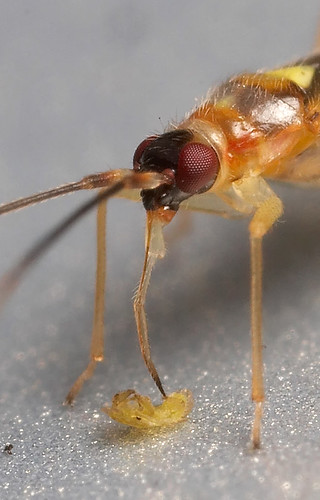Diptera.info :: Identification queries :: Other insects, spiders, etc.
Who is here? 1 guest(s)
|
Bug question
|
|
| LordV |
Posted on 11-07-2006 06:59
|
|
Member Location: Posts: 673 Joined: 06.09.05 |
I've noticed on bugs with erectile probosci, that when erect there seems to be a thread running down the front of the proboscis which sometimes is clear of the sheath. Does anyone know if this is the tongue or whether it is some type of erector muscle? Pic of small bug about 5mm long (some type of capsid bug I think) Brian V.  |
|
|
|
| Robert Nash |
Posted on 11-07-2006 09:10
|
|
Member Location: Ulster Museum, Belfast, Ireland Posts: 288 Joined: 11.11.05 |
"The mouthparts of Hemiptera, both Heteroptera and Homoptera, are adapted for piercing and sucking. They include parts of the mandibles, maxillae, and labium which collectively form a prominent beak, or rostrum, extending from the ventral extremity of the labrum (Fig. 3, 21-4). The beak consists of the modified labium, which forms a support for a slender delicate stylet made of the mandibles and maxillae. Most of what you see on your specimen is the labium. It is a sturdy, 3-jointed structure with a distinct, deep groove on its anterior surface (Fig. 4). The dark sclerotized stylet can be seen emerging from the tip of the labrum and disappearing into the groove. In use, the labium folds at its joints and leaves the stylet exposed to penetrate the prey. The labium does not penetrate. The stylet consists of a long slender process from each mandible and each maxilla, for a total of four processes. The two maxillae together form a central tube with two channels, one inbound for food and leading to the mouth, the other outbound for saliva and leading from the salivarium and salivary ducts (Fig. 4). The mandibles form a tube around the maxillae. Maxillae and mandibles are equipped with protractor and retractor muscles." Extract from http://www.lander.edu/rsfox/310tibicenlab.html A laboratory manual relating to the cicada. Your "thread", if I understand you properly, is the tube formed by the adpressed stylets. I'm grateful to you here   . I noticed a lot of confusion . I noticed a lot of confusion in webpages relating to insect mouthparts while looking for a pic (the Wikipage being less than clear.I'll discuss this with the page authors and correct it). If you need a simpler word form let me know. in webpages relating to insect mouthparts while looking for a pic (the Wikipage being less than clear.I'll discuss this with the page authors and correct it). If you need a simpler word form let me know.Cheers Robert Edited by Robert Nash on 11-07-2006 09:21 |
| Jump to Forum: |













